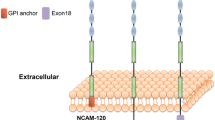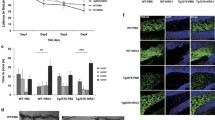Abstract
The neural cell adhesion molecule, NCAM, is ubiquitously expressed within the CNS and has roles in development, cognition, neural plasticity and regulation of the immune system. NCAM is thus potentially an important pharmacological target for treatment of brain diseases. A cell adhesion mimetic FGL, a 15 amino-acid peptide derived from the second fibronectin type-III module of NCAM, has been shown to act as a neuroprotective agent in experimental disease and ageing models, restoring hippocampal/cognitive function and markedly alleviating deleterious changes in the CNS. However, the effects of FGL on the hippocampus of young healthy rats are unknown. The present study has examined the cellular neurobiological consequences of subcutaneous injections of FGL, on hippocampal cell morphometry in young (4 month-old) rats. We determined the effects of FGL on hippocampal volume, pyramidal neuron number/density (using unbiased quantitative stereology), and examined aspects of neurogenesis (using 2D morphometric analyses). FGL treatment reduced total volume of the dorsal hippocampus (associated with a decrease in total pyramidal neuron numbers in CA1 and CA3), and elevated the number of doublecortin immunolabeled neurons in the dentate gyrus, indicating a likely influence on neurogenesis in young healthy rats. These data indicate that FGL has a specific age dependent effect on the hippocampus, differing according to the development and maturity of the CNS.





Similar content being viewed by others
References
Berezin V, Bock E, Poulsen F (2000) The neural cell adhesion molecule NCAM. Curr Opin Drug Discov Dev 3:605–609
Cavallaro S, D’Agata V, Manickam P, Dufour F, Alkon DL (2002) Memory-specific temporal profiles of gene expression in the hippocampus. Proc Natl Acad Sci USA 99:16279–16284
Cremer H, Lange R, Christoph A, Plomann M, Vopper G, Roes J, Brown R, Baldwin S, Kraemer P, Scheff S, Barthels D, Rajewsky K, Wille W (1994) Inactivation of the N-CAM gene in mice results in size reduction of the olfactory bulb and deficits in spatial learning. Nature 367:455–459
Crossin KL, Krushel LA (2000) Cellular signaling by neural cell adhesion molecules of the immunoglobulin superfamily. Dev Dyn 218:260–279
Luthl A, Laurent JP, Figurov A, Muller D, Schachner M (1994) Hippocampal long-term potentiation and neural cell adhesion molecules L1 and NCAM. Nature 372:777–779
Neiiendam JL, Kohler LB, Christensen C, Li S, Pedersen MV, Ditlevsen DK, Kornum MK, Kiselyov VV, Berezin V, Bock E (2004) An NCAM-derived FGF-receptor agonist, the FGL-peptide, induces neurite outgrowth and neuronal survival in primary rat neurons. J Neurochem 91:920–935
Berezin V, Bock E (2004) NCAM mimetic peptides: pharmacological and therapeutic potential. J Mol Neurosci 22:33–39
Kiselyov VV, Skladchikova G, Hinsby AM, Jensen PH, Kulahin N, Soroka V, Pedersen N, Tsetlin V, Poulsen FM, Berezin V, Bock E (2003) Structural basis for a direct interaction between FGFR1 and NCAM and evidence for a regulatory role of ATP. Structure 11:691–701
Walmod PS, Kolkova K, Berezin V, Bock E (2004) Zippers make signals: NCAM mediated molecular interactions and signal transduction. Neurochem Res 29:2015–2035
Berezin V, Bock E (2010) NCAM mimetic peptides: an update. Adv Exp Med Biol 663:337–353
Hansen SM, Li S, Bock E, Berezin V (2010) Synthetic NCAM-derived ligands of the fibroblast growth factor receptor. Adv Exp Med Biol 663:355–372
Cambon K, Hansen SM, Venero C, Herrero AI, Skibo G, Berezin V, Bock E, Sandi C (2004) A synthetic neural cell adhesion molecule mimetic peptide promotes synaptogenesis, enhances presynaptic function, and facilitates memory consolidation. J Neurosci 24:4197–4204
Downer EJ, Cowley TR, Lyons A, Mills KHG, Berezin V, Bock E, Lynch MA (2010) A novel anti-inflammatory role of NCAM-derived mimetic peptide, FGL. Neurobiol Aging 31:118–128
Klementiev B, Novikova T, Novitskaya V, Walmod PS, Dmytriyeva O, Pakkenberg B, Berezin V, Bock E (2007) A neural cell adhesion molecule-derived peptide reduces neuropathological signs and cognitive impairment induced by Abeta25-35. Neuroscience 145:209–224
Popov VI, Medvedev NI, Kraev IV, Gabbott PL, Davies HA, Lynch M, Cowley TR, Berezin V, Bock E, Stewart MG (2008) A cell adhesion molecule mimetic, FGL peptide, induces alterations in synapse and dendritic spine structure in the dentate gyrus of aged rats: a three-dimensional ultrastructural study. Eur J Neurosci 27:301–314
Skibo GG, Lushnikova IV, Voronin KY, Dmitrieva O, Novikova T, Klementiev B, Vaudano E, Berezin VA, Bock E (2005) A synthetic NCAM-derived peptide, FGL, protects hippocampal neurons from ischemic insult both in vitro and in vivo. Eur J Neurosci 22:1589–1596
Stewart M, Popov V, Medvedev N, Gabbott P, Corbett N, Kraev I, Davies H (2010) Dendritic spine and synapse morphological alterations induced by a neural cell adhesion molecule (NCAM) mimetic. Adv Exp Med Biol 663:373–383
Ojo B, Rezaie P, Gabbott PL, Colyer F, Medvedev N, Cowley TR, Lynch M, Stewart M (2011) A neural cell adhesion molecule-derived peptide, FGL, attenuates glial cell activation in the aged hippocampus. Exp Neurol 232:318–328
Ojo B, Rezaie P, Gabbott PL, Davies H, Colyer F, Medvedev N, Cowley TR, Lynch M, Stewart M (2011) Age-related changes in the hippocampus (loss of synaptophysin and glial-synaptic interaction) are modified by systemic treatment with an NCAM-derived peptide, FGL. Brain Behav Immun 26:778–788
Borcel E, Perez-Alvarez L, Herrero AI, Brionne T, Varea E, Berezin V, Bock E, Sandi C, Venero C (2008) Chronic stress in adulthood followed by intermittent stress impairs spatial memory and the survival of newborn hippocampal cells in ageing animals: prevention by FGL, a peptide mimetic of neural cell adhesion molecule. Behav Pharmacol 19:41–49
Jung MW, Weiner SI, McNaughton BL (1994) Comparison of spatial firing characteristics of units in dorsal and ventral hippocampus of the rat. J Neurosci 14:7347–7356
Moser MB, Moser EI, Forrest E, Anderson P, Morris RGM (1995) Spatial learning with minislab in the dorsal hippocampus. Proc Natl Acad Sci USA 92:9697–9701
Secher T, Novitskaia V, Berezin V, Bock E, Glenthoj B, Klementiev B (2006) A neural cell adhesion molecule-derived fibroblast growth factor receptor agonist, the FGL-peptide, promotes early postnatal sensorimotor development and enhances social memory retention. Neuroscience 141:1289–1299
Paxinos G, Watson C (2007) The rat brain in stereotactic co-ordinates, 6th edn. Academic Press, London
Pakkenberg B, Gundersen HJ (1997) Neocortical neuron number in humans: effect of sex and age. J Comp Neurol 384:312–320
Popov VI, Davies HA, Rogachevskii VV, Errington ML, Gabbott PLA, Bliss TVP, Stewart MG (2004) Remodelling of synaptic morphology but unchanged synaptic density during late phase LTP: a serial section EM study of the dentate gyrus in the anaesthetised rat. Neuroscience 28:251–262
Stewart MG, Davies HA, Sandi C, Kraev IV, Rogachevsky VV, Rodriguez JJ, Cordero IM, Donohue HS, Gabbott PLA, Peddie CJ, Popov VI (2005) Stress suppresses and learning induces expression of ultrastructural plasticity in CA3 of rat hippocampus: a 3dimensional ultrastructural study of thorny excrescences and their post synaptic densities. Neuroscience 131:43–54
Gundersen HJ, Jensen EB (1987) The efficiency of systematic sampling in stereology and its prediction. J Microsc 147:229–263
West M, Slomianka JL, Gundersen HJ (1991) Unbiased stereological estimation of the total number of neurons in the subdivisions of the rat hippocampus using the optical fractionator. Anat Rec 231:482–497
Howard CV, Reed MG (1998) Unbiased stereology. Three-dimensional measurement in microscopy. Microscopy handbooks, vol 41. Royal microscopical society. BIOS Scientific Publishers Ltd., Oxford
West MJ (1993) New stereological methods for counting neurons. Neurobiol Ageing 14:275–285
West MJ (1993) Regionally specific loss of neurons in the ageing human hippocampus. Neurobiol Ageing 14:287–293
Rapp PR, Gallagher M (1996) Preserved neuron number in the hippocampus of aged rats with spatial learning deficits. Proc Natl Acad Sci USA 93:9926–99230
Mihalick SM, Crandall JE, Langlois JC, Krienke JD, Dube WV (2001) Prenatal ethanol exposure, generalized learning impairment, and medial prefrontal cortical deficits in rats. Neurotoxicol Teratol 23:453–462
Kraev IV, Godukhin OV, Patrushev IV, Davies HA, Popov VI, Stewart MG (2009) Partial kindling induces neurogenesis, activates astrocytes and alters synaptic morphology in the dentate gyrus of freely moving adult rats. Neuroscience 162:254–267
Stadelmann C, Lassmann H (2000) Detection of apoptosis in tissue sections. Cell Tissue Res 301:19–31
Rasmussen T, Schliemann T, Sorensen JC, Zimmer J, West MJ (1996) Memory impaired aged rats: no loss of principal hippocampal and subicular neurons. Neurobiol Ageing 17:143–147
Chadashvili T, Peterson DA (2006) Cytoarchitecture of fibroblast growth factor receptor 2 (FGFR-2) immunoreactivity in astrocytes of neurogenic and non-neurogenic regions of the young adult and aged rat brain. J Comp Neurol 498:1–15
Brown JP, Couillard-Després S, Cooper-Kuhn CM, Winkler J, Aigner L, Kuhn HG (2003) Transient expression of doublecortin during adult neurogenesis. J Comp Neurol 467:1–10
Gleeson JG, Lin PT, Flanagan LA, Walsh CA (1999) Doublecortin is a microtubule-associated protein and is expressed widely by migrating neurons. Neuron 23:257–2571
Berg MJ, Schifitto G, Powers JM, Martinez-Capolino C, Fong CT, Myers GJ, Epstein LG, Walsh CA (1998) X-linked 1 (Novagen, Madison, WI) vector and protein produced in BL21 E. coli (Stratagene), according to the Manu female band heterotopia–male lissencephaly syndrome. Neurology 50:1143–1146
Stachowiak EK, Roy I, Lee YW, Capacchietti M, Aletta JM, Prasad PN, Stachowiak MK (2009) Targeting novel integrative nuclear FGFR1 signaling by nanoparticle-mediated gene transfer stimulates neurogenesis in the adult brain. Integr Biol (Camb) 1:394–403
Yoshimura S, Takagi Y, Harada J, Teramoto T, Thomas SS, Waeber C, Bakowska JC, Breakefield XO, Moskowitz MA (2001) FGF-2 regulation of neurogenesis in adult hippocampus after brain injury. Proc Natl Acad Sci USA 98:5874–5879
Jin K, Sun Y, Xie L, Batteur S, Mao XO, Smelick C, Logvinova A, Greenberg DA (2003) Neurogenesis and ageing: FGF-2 and HB-EGF restore neurogenesis in hippocampus and subventricular zone of aged mice. Ageing Cell 2:175–183
Rai KS, Hattiangady B, Shetty AK (2007) Enhanced production and dendritic growth of new dentate granule cells in the middle-aged hippocampus following intracerebroventricular FGF-2 infusions. Eur J Neurosci 26:1765–1779
Acknowledgments
Supported by the European Union FPVI “Promemoria” programme grant (Contract No. 512012) and FP7 ‘MemStick’ (Ref: 201600) and BBSRC grant No. BB/1020330/1.
Author information
Authors and Affiliations
Corresponding author
Additional information
Special Issue: Elisabeth Bock.
Rights and permissions
About this article
Cite this article
Ojo, B., Gabbott, P.L., Rezaie, P. et al. An NCAM Mimetic, FGL, Alters Hippocampal Cellular Morphometry in Young Adult (4 Month-Old) Rats. Neurochem Res 38, 1208–1218 (2013). https://doi.org/10.1007/s11064-012-0908-9
Received:
Revised:
Accepted:
Published:
Issue Date:
DOI: https://doi.org/10.1007/s11064-012-0908-9




